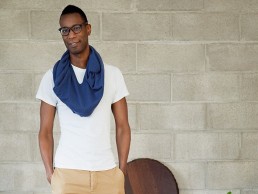
Garth Roberts
Garth Roberts founded his studio in 2010 after a series of pop-up studio projects in collaboration with Universities in Milan, Berlin and New York. Before forming his studio, Roberts gained his experience as part of prestigious design teams in North America and Europe, and today his studio works in different fields of product design and creative direction, developing projects for clients such as Glas Itali, Mabeo Furniture, Serralunga, Casamania, and the LRRH_ Art Project.
Since 2009 Roberts has been based in Berlin but continues to work between Milan and New York. Now the creative director of lighting brand Kalmar, Roberts took time out of his busy schedule for a quick Q & A with darc.
Can you tell our readers a little about yourself?
I was born and raised in Canada, where I studied design. After my first year of work experience I decided to take a trip to New York. At that time in my life I absolutely hated travelling, so to this day I don’t know what possessed me to embark upon this adventure. That two-week trip changed what I understood as design and the potential that design had to offer.
When did you realise you wanted a career in design?
I was drawing consistently from a young age, but it wasn’t until I was about seventeen when I understood that creativity could be considered part of my professional aspirations. After this realisation I spent every moment I could trying to understand what design actually was and how my interest in science and history could merge with my creative aspirations.
Who and what inspires / influences you?
In the beginning my main influences came from magazines, I remember waiting with bated breath to get my hands on the most recent monthly design magazine, it was my window to the glamour of design. Now I behave in a way that is the polar opposite of how I did at the start. I almost avoid design magazines completely (of course darc is the exception to that rule!). My current inspiration is how creativity cross-pollinates, so my diet consists of modern dance, art openings and films.
What is it about lighting that specifically appeals to you from a design perspective?
Lighting is the most liberal of all genres related to product, when you’re designing lighting you determine how complex and poetic the final design will be. If it’s done well whatever you decide to do has the potential to be accepted and appreciated. For me this freedom doesn’t really exist in other product groups because the requirements have a direct connection with the human body and anatomy. Lighting brings items to life. If it is done well it calms the nerves.
Can you tell us about some of your most notable projects?
My project history ranges from the more rationally designed projects for Kalmar to more conceptual, expressive works such as the crate collection for Mabeo Furniture. As the creative director of Kalmar I have to consider the brand’s established design history and vintage products. The Hase, Billy and Kilo series of lamps are all examples of this mentality. In pieces like the Quake table for Glas Italia, After Party rug for cc-tapis, Zanotta’s RAW table, the Crate Collection and Mabeo’s Seri Stool, I have more flexibility to express the tension of materials and the sophisticated crudeness of intent in my work.
How would you describe your signature style?
I think my style is quite sophisticated yet basic, with a sense of tension. This tension is embodied in contrasting materials, the use of colour and texture or lack thereof. I like to leave a crude or unstudied undertone to my work. I aim to communicate an uncontrived simplicity and approachability to those that encounter the design.
What trends are you seeing in decorative lighting at the moment and how do you see it continuing to progress?
The attention that was given to lighting as a typology has intensified in the last few years, because of this the variety and quantity of lamp designs have increased dramatically when compared to the past decade. The trends that stand out to my sensitivities are the sculptural ideas expressed via the forms. The lamp is no longer just considered an accent piece; it is now often competing as the focal piece in the interior landscape.
Do you have any collaborations or projects lined up that you can share with us?
We’ve started a few new collaborations; one in particular focuses on using natural fibres. I find this particularly interesting because of its connection to handcraft and the origins of design. I will continue working with cc-tapis, Kalmar Werkstaetten and Mabeo furniture, developing some new projects that expand some of our existing object series and initiate some new directions.
If you could sum up working with light in one sentence what would it be?
Working with light means trying to give a full sensory experience and embody something that borders on intangible to every sense except sight.



